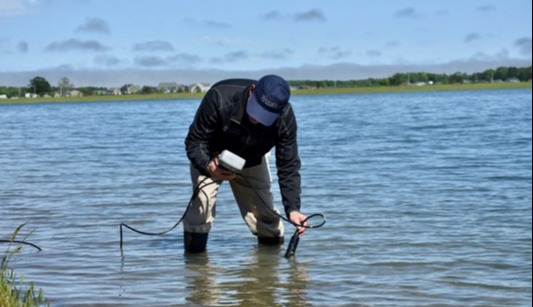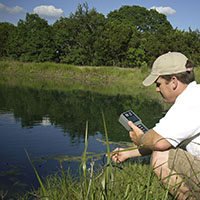Water testing is often considered when a fish kill occurs or when research about the suitability of a water body for a species of fish. What I learned as a Water treatment expert and an avid fisherman is that most fish have a preference for certain water quality parameters that can be determined with minimal equipment. How to Use a Digital Water Tester For Fishing?
To use a digital water tester for fishing, simply dip it into the H2O you are fishing in & follow the instructions to measure parameters like pH, dissolved oxygen, and temperature. Use the results to gauge H2O quality, fish species, the best fishing spots, & adapt your techniques for optimal success.
Introduction:
Digital water testers are sophisticated devices designed to measure various parameters of water quality with precision and accuracy. These testers utilize advanced technology to assess factors such as pH levels, dissolved oxygen content, temperature, and conductivity.
They offer a convenient and efficient alternative to traditional testing methods, providing anglers with real-time data for informed decision-making. Digital water testers come in portable and user-friendly designs, making them accessible to anglers of all experience levels. With their ability to assess water quality on the spot, digital testers empower anglers to optimize their fishing strategies and enhance their overall fishing experience.
Water quality profoundly impacts the health and behavior of fish, directly influencing their survival and abundance in aquatic ecosystems. Factors such as pH levels, dissolved oxygen concentration, and temperature play crucial roles in determining fish habitat suitability and reproductive success.
Poor water quality can lead to stressed or diseased fish populations, resulting in decreased feeding activity and reduced angling success. Maintaining optimal water quality is essential for sustaining healthy fish populations and ensuring enjoyable fishing experiences for anglers. By understanding and monitoring water quality, anglers can contribute to the conservation and preservation of aquatic environments.
How to Use a Digital Water Tester for Fishing
Digital water testers are electronic devices designed to measure various parameters of water quality accurately and efficiently. These testers utilize sensors and advanced technology to analyze key factors such as pH levels, dissolved oxygen content, temperature, conductivity, and turbidity.

There are several types of digital water testers available, including handheld, portable, and benchtop models, each suited for different applications and environments. When choosing a digital water tester, it’s essential to consider factors such as measurement range, accuracy, ease of use, durability, and battery life. Selecting a tester with the right features ensures reliable data collection and optimal performance for fishing and other water-related activities.
- Gather Necessary Equipment: Before conducting water quality tests, ensure you have all the required equipment, including the digital water tester, calibration solutions, sample containers, gloves, and any additional accessories specific to your testing needs.
- Selecting Appropriate Testing Locations: Choose testing locations that accurately represent the areas where you intend to fish, considering factors such as water depth, flow rate, proximity to potential sources of pollution, and accessibility. Select multiple locations to obtain a comprehensive understanding of water quality in different environments.
- Safety Precautions: Prioritize safety by wearing appropriate personal protective equipment, such as gloves and non-slip shoes, especially when handling water samples or operating equipment near water bodies. Be mindful of potential hazards, such as slippery surfaces, unstable terrain, or wildlife encounters, and take necessary precautions to prevent accidents or injuries. Follow local regulations and guidelines for water testing to ensure compliance and minimize environmental impact. Keep emergency contacts handy and inform others about your testing activities, especially if conducting tests in remote or isolated areas. Regularly assess and mitigate risks to ensure a safe and productive testing experience.
- Team up with another Angler
Conducting Water Quality Tests
pH Level Testing:
Calibrate the pH meter according to manufacturer instructions using calibration solutions.
Collect a water sample in a clean container.
Immerse the pH electrode into the water sample and wait for the reading to stabilize.
Record the pH value displayed on the meter.
Rinse the electrode with clean water between samples to prevent cross-contamination.
Interpreting pH Results for Fishing:
Optimal pH levels for fish vary depending on species but generally range between 6.5 to 8.5.
pH levels outside this range may indicate water acidity or alkalinity, which can impact fish health and behavior.
Fish tend to be more active and feed more actively in waters with neutral pH levels close to 7.0.
Extreme pH levels can stress fish and reduce their overall activity, affecting fishing success.
Dissolved Oxygen (DO) Testing:
Ensure the dissolved oxygen meter is calibrated properly using standard solutions.
Submerge the DO probe into the water sample, ensuring it is free from air bubbles.
Allow sufficient time for the reading to stabilize.
Record the dissolved oxygen concentration displayed on the meter.
Repeat the process at different depths and locations for a comprehensive assessment.
Interpreting DO Results for Fishing:
Dissolved oxygen levels above 5 mg/L are generally sufficient for most freshwater fish species.
Low dissolved oxygen levels can lead to fish stress, reduced feeding activity, and even mortality.
Monitoring DO levels helps anglers identify areas with adequate oxygen for fish survival and activity.
Oxygen-rich environments typically attract more fish and offer better fishing opportunities.

Temperature Testing:
Use a waterproof thermometer to measure water temperature at the surface and various depths.
Submerge the thermometer into the water sample and allow it to stabilize for accurate readings.
Record the water temperature at each location.
Take multiple measurements throughout the day to account for temperature fluctuations.
Avoid touching the bottom or sides of the water body with the thermometer to prevent inaccurate readings.
Significance of Temperature in Fishing:
Water temperature influences fish metabolism, feeding behavior, and spawning activities.
Many fish species have preferred temperature ranges for feeding and activity.
Understanding water temperature variations helps anglers identify optimal fishing times and locations.
Warm water temperatures may increase fish activity, while cold temperatures can slow down their metabolism and reduce feeding.
Additional Parameters
Conductivity:
Conductivity measures the water’s ability to conduct electrical current, indicating the presence of dissolved ions.
High conductivity levels may indicate pollution or mineral-rich waters.
Low conductivity levels may suggest low mineral content or dilution by rainfall.
Conductivity data provides valuable insights into water quality and ecosystem health.
Turbidity:
Turbidity measures the cloudiness or clarity of water caused by suspended particles.
High turbidity levels can interfere with fish vision and feeding behavior.
Turbid waters may indicate sediment runoff, algae blooms, or other environmental disturbances.
Monitoring turbidity helps assess water quality and identify potential impacts on fish habitat.
Understanding the Impact of Water Quality on Fish Behavior
The impact of water quality on fish behavior is profound and multifaceted. Fluctuations in parameters such as pH levels, dissolved oxygen content, and temperature directly influence fish behavior, including feeding patterns, migration routes, and reproductive activities.

Poor water quality, characterized by high levels of pollutants or imbalances in key parameters, can induce stress responses in fish, leading to reduced feeding activity, altered swimming behaviors, and compromised immune systems. Additionally, extreme variations in water quality can disrupt fish populations, causing declines in abundance and diversity and impacting the overall health of aquatic ecosystems. Understanding and maintaining optimal water quality conditions are essential for sustaining healthy fish populations and preserving balanced aquatic habitats.
Water quality significantly influences fish behavior, including feeding habits, spawning behavior, and movement patterns. For example, certain fish species are more tolerant of specific pH levels, dissolved oxygen concentrations, and temperature ranges.
Changes in water quality parameters can trigger physiological stress responses in fish, affecting their growth, reproduction, and overall health. Additionally, poor water quality can lead to reduced foraging activity, decreased aggression, and altered habitat preferences among fish populations. Understanding how fish respond to variations in water quality is crucial for successful angling and sustainable fisheries management.
Tips for Effective Testing
- Regularly calibrate your digital water tester according to manufacturer instructions to ensure accurate and reliable measurements.
- Take multiple readings at different locations and depths within the water body to obtain a comprehensive understanding of water quality variations.
- Keep detailed records of test results, including time, date, location, and environmental conditions, to track changes over time and identify trends.
- Familiarize yourself with the specific water quality requirements and preferences of the fish species you’re targeting to interpret test results more effectively.
- Stay informed about local regulations and guidelines for water testing, and collaborate with relevant authorities or organizations to contribute to broader monitoring efforts and conservation initiatives.
Conclusion:
Digital water testers offer anglers a convenient and efficient way to assess water quality in real-time, empowering them to optimize their fishing strategies and improve their overall fishing experiences. Investing in a digital water tester enables anglers to make more informed decisions and adapt to changing environmental conditions, ultimately increasing their chances of success on the water. As stewards of the environment, anglers play a crucial role in conserving and protecting aquatic ecosystems for future generations. By prioritizing water quality testing and adopting sustainable fishing practices, anglers can contribute to the preservation of healthy fish populations and thriving aquatic habitats. Let’s continue to work together to ensure clean and healthy waters for all to enjoy.
References:
Ohio State Un.-Water Quality Testing and Fish Health
FAQ’s
- Are there any specific guidelines for interpreting the test results for fishing purposes?
Interpreting test results for fishing purposes can vary depending on the parameters measured and the fish species targeted. However, some general guidelines include:
- pH Levels: Fish generally prefer water with neutral to slightly acidic pH levels (around 6.5 to 7.5), but preferences can vary among species. Higher or lower pH levels may indicate water quality issues that could affect fish health and behavior.
- Dissolved Oxygen (DO): Most fish require adequate dissolved oxygen levels (typically above 5 mg/L) for survival. Low DO levels can indicate poor water quality or stressful conditions for fish, while high DO levels can support increased fish activity and feeding.
- Temperature: Fish have preferred temperature ranges for feeding, spawning, and overall activity. Monitoring water temperature can help anglers identify optimal fishing times and locations, as well as understand seasonal patterns in fish behavior.
- Conductivity and Turbidity: While not always necessary for fishing purposes, conductivity and turbidity measurements can provide additional insights into water quality and potential impacts on fish habitat and behavior.
- How often should I test the water quality while fishing?
The frequency of water quality testing while fishing depends on various factors, including the stability of the fishing location and any changes observed in the environment or fish behavior. As a general guideline, testing at the beginning of your fishing trip and periodically throughout the day can help ensure that you’re aware of any significant changes in water quality. Additionally, if you notice sudden alterations in fish activity or environmental conditions, conducting immediate tests can help you adapt your fishing strategies accordingly.



